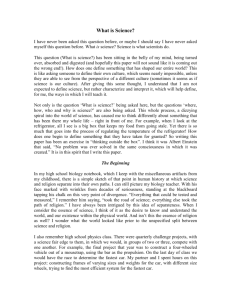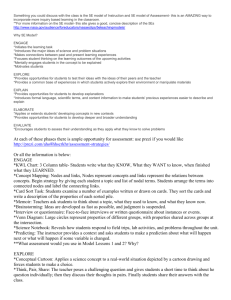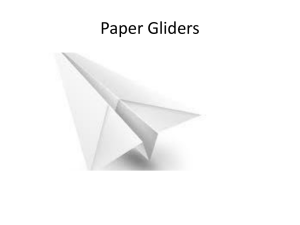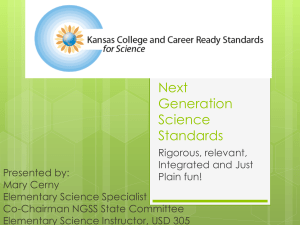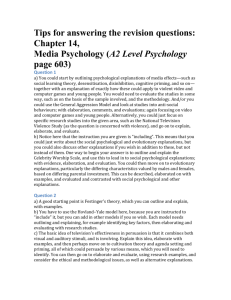BSCS 5E Instructional Model - San Diego State University
advertisement
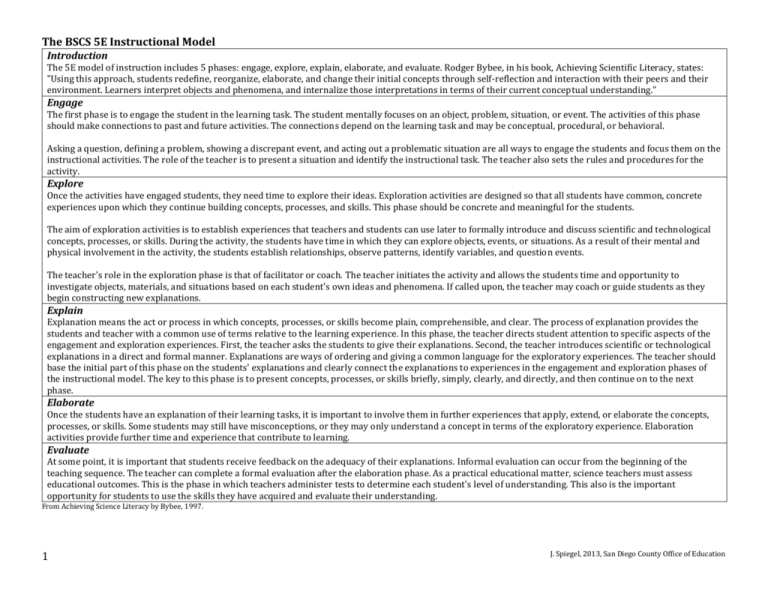
The BSCS 5E Instructional Model Introduction The 5E model of instruction includes 5 phases: engage, explore, explain, elaborate, and evaluate. Rodger Bybee, in his book, Achieving Scientific Literacy, states: "Using this approach, students redefine, reorganize, elaborate, and change their initial concepts through self-reflection and interaction with their peers and their environment. Learners interpret objects and phenomena, and internalize those interpretations in terms of their current conceptual understanding." Engage The first phase is to engage the student in the learning task. The student mentally focuses on an object, problem, situation, or event. The activities of this phase should make connections to past and future activities. The connections depend on the learning task and may be conceptual, procedural, or behavioral. Asking a question, defining a problem, showing a discrepant event, and acting out a problematic situation are all ways to engage the students and focus them on the instructional activities. The role of the teacher is to present a situation and identify the instructional task. The teacher also sets the rules and procedures for the activity. Explore Once the activities have engaged students, they need time to explore their ideas. Exploration activities are designed so that all students have common, concrete experiences upon which they continue building concepts, processes, and skills. This phase should be concrete and meaningful for the students. The aim of exploration activities is to establish experiences that teachers and students can use later to formally introduce and discuss scientific and technological concepts, processes, or skills. During the activity, the students have time in which they can explore objects, events, or situations. As a result of their mental and physical involvement in the activity, the students establish relationships, observe patterns, identify variables, and question events. The teacher's role in the exploration phase is that of facilitator or coach. The teacher initiates the activity and allows the students time and opportunity to investigate objects, materials, and situations based on each student's own ideas and phenomena. If called upon, the teacher may coach or guide students as they begin constructing new explanations. Explain Explanation means the act or process in which concepts, processes, or skills become plain, comprehensible, and clear. The process of explanation provides the students and teacher with a common use of terms relative to the learning experience. In this phase, the teacher directs student attention to specific aspects of the engagement and exploration experiences. First, the teacher asks the students to give their explanations. Second, the teacher introduces scientific or technological explanations in a direct and formal manner. Explanations are ways of ordering and giving a common language for the exploratory experiences. The teacher should base the initial part of this phase on the students' explanations and clearly connect the explanations to experiences in the engagement and exploration phases of the instructional model. The key to this phase is to present concepts, processes, or skills briefly, simply, clearly, and directly, and then continue on to the next phase. Elaborate Once the students have an explanation of their learning tasks, it is important to involve them in further experiences that apply, extend, or elaborate the concepts, processes, or skills. Some students may still have misconceptions, or they may only understand a concept in terms of the exploratory experience. Elaboration activities provide further time and experience that contribute to learning. Evaluate At some point, it is important that students receive feedback on the adequacy of their explanations. Informal evaluation can occur from the beginning of the teaching sequence. The teacher can complete a formal evaluation after the elaboration phase. As a practical educational matter, science teachers must assess educational outcomes. This is the phase in which teachers administer tests to determine each student's level of understanding. This also is the important opportunity for students to use the skills they have acquired and evaluate their understanding. From Achieving Science Literacy by Bybee, 1997. 1 J. Spiegel, 2013, San Diego County Office of Education Teacher and Student Activities in the BSCS 5E Instructional Model 5E Stage Engage Student Behaviors Teaching Strategies Asks questions such as, Why did this happen? What do I already know about this? What can I find out about this? How can this problem be solved? Shows interest in the topic. Engages in problem, expresses own ideas. Test predictions and hypotheses. Forms new predictions and hypotheses. Discusses problems with others. Records observations and ideas. Explains possible solutions or answers to other students. Listens critically to and questions other explanations. Listens to explanations offered by the teacher. Refers to investigation. Uses evidence from investigation in explanations. Initiates the learning task, accesses prior knowledge, and organizes student thinking toward outcomes of current activities. Explore Explain Common base of experiences within which concepts, processes, and skills are developed. Students demonstrate their understanding. Teacher provides resources and information to support student learning. Formal definitions and scientists’ details are provided. Elaborate Students’ understanding is challenged and extended, skills further developed. Application of knowledge to new situations. Evaluate Teacher and students assess understanding and skills. Assessment is formal and informal, summative and formative. Applies new labels, definitions, explanations, and skills in new, but similar, situations. Uses previous information to ask questions, propose solutions, make decisions, design experiments, or complete a challenge. Draws reasonable conclusions from evidence. Records observations and explanations. Student gives another student feedback. Evaluates his or her progress or knowledge. Checks work with a rubric. Raises questions or problems. Elicits responses that uncover students’ current knowledge about the concept/topic. Helps students make connections to previous work. Posts learning outcomes and explicitly references them in the lesson. Provides question or problem. Provides common experience. Observes and listens to students as they interact. Acts as a consultant for students. Encourages students to explain concepts and definitions in their own words. Asks for justification (evidence) and clarification from students. Formally provides definitions, explanations, and new vocabulary through mini lecture, text, internet, or other resources. Builds on student explanations. Expects students to use vocabulary, definitions, and explanations provided previously in new context. Encourages students to apply the concepts and skills in new situations. Provide alternative explanations. Asks open-ended questions such as, “Why do you think…?” “What evidence do you have?” “How would you answer the question?” Observe students. Gathers evidence of student understanding. Variety of assessments. From Achieving Science Literacy by Bybee, 1997. 2 J. Spiegel, 2013, San Diego County Office of Education

